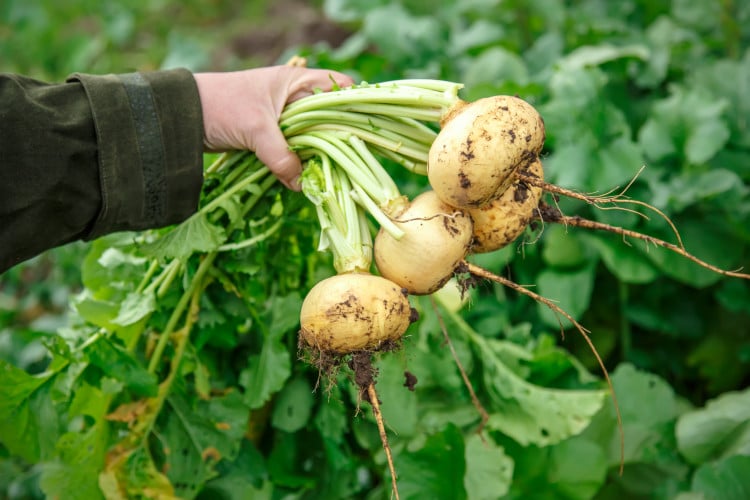The tantalizing turnip is a tremendous vegetable if ever there was one. With hardy roots and succulent leaves, this long-standing vegetable can really pack a punch. Both on your taste buds and as a source of nutrition.
A turn for turnips
Turnips can be sown in spring, ready to harvest in the summer months. If you plant one every ten days, you’ll be able to harvest all summer long. Plant in moist soil and sow the seeds 1cm deep.
It’s important to keep them well watered to prevent roots from becoming tough. Sow sparingly to avoid overcrowding and decreased speed of growth.
Plus, they grow (and taste) great alongside carrots and radishes, making them a scrumptious addition to your salad.
Known as an easy grower, they will take roughly two months until they are ready to cultivate. It’s important to thin your turnips to around 10cm as this will give the plant a good deal of space to form healthy roots.

Tantalizing taste buds

For more of a sweet and tender flavour, turnips are best being pulled up when they are still quite small. Turnips possess an abundance of vitamins and minerals. They are a great source of B vitamins, whilst also being high in vitamins A, C, E and K.
Vitamin A is great at protecting your eyes, especially when it comes to age-related deterioration. Whereas vitamin C is known for keeping your immune system happy and healthy.
It’s not just the bulb that has a wealth of flavour, the leaves do too! As part of the Brassicaceae family, they are equally as nutritious as cruciferous greens, like broccoli and kale.
When harvested in the morning, turnip greens possess a pungent flavour that are best when consumed within a couple of hours of harvesting. And, just one cup of cooked turnip greens contains 1.15mg of iron.
Traditional turnip
A turnip is a hardy root vegetable. So hardy in fact, they were thought to be considered food for the lower classes because of how well they would grow in cheaper soils. Often, the higher classes would refuse to eat them.
During the 15th century, people would toss a turnip at a hated public figure. And the phrase ‘turnip eater’ was used as a derogatory term. Having been around for over 4,000 years, the Romans loved turnips in their cuisine and, much like the Romans, we can’t get enough of them!
When Roman culture first introduced them to Britain, we’d feast on them alongside succulent meats such as duck. So, plant turnips as a tasty treat now and you can continue with this hearty tradition.

What to harvest in summer?

Back in February, we began sowing carrots. Well, the time has come to harvest your veg. Check out the blog for more reasons to get sowing. Super sweet, these nutritious little gems work wonders in salads. Along with celery and coriander, baby carrots are part of the Umbelliferae family. And add a satisfying crunch when tossed into salads.
For a simple light dish that is summer fresh and bursting with flavour, give this salad a go. All you need is:
A handful of baby carrots
1 lemon
½ bunch Parsley
1 shallot
Dijon mustard
125ml olive oil
Start by grating the carrots into a bowl. Select a smaller bowl to mix together the mustard and shallots. Once cut in half, zest your lemon saving it for later. Add the juice from the other half to your mixture. Drizzle in the olive oil, seasoning with salt and pepper to taste. Pop in the parsley to the bowl of carrots and add your dressing.

Leave A Comment